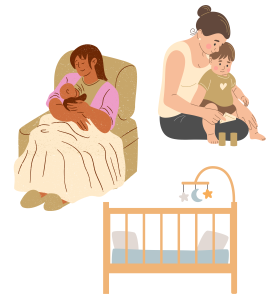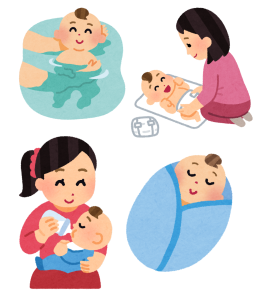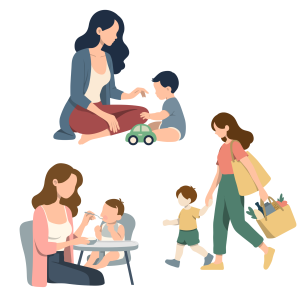12
Mother-Baby Dyad
 The relationship between mothers and infants, often referred to as the mother-baby dyad, recognizes that both parties have intricate needs that are interlinked. This holistic perspective considers various stages of motherhood, including pregnancy, labor, delivery, and the postpartum period, while also emphasizing that interventions designed to support one can positively affect the other. A significant focus is placed on maternal mental health, as feeling confident and capable in the new role of motherhood is crucial for both the mother’s and the baby’s well-being.
The relationship between mothers and infants, often referred to as the mother-baby dyad, recognizes that both parties have intricate needs that are interlinked. This holistic perspective considers various stages of motherhood, including pregnancy, labor, delivery, and the postpartum period, while also emphasizing that interventions designed to support one can positively affect the other. A significant focus is placed on maternal mental health, as feeling confident and capable in the new role of motherhood is crucial for both the mother’s and the baby’s well-being.
The emphasis on the mother-baby dyad extends beyond the basic requirements of survival for both. It includes fostering an environment where mothers can enjoy the journey of motherhood and thrive alongside their infants. In this regard, occupational therapy plays a vital role in facilitating positive development for both mothers and babies. For instance, infants may face challenges such as delayed reflexes—this could manifest as difficulties in grasping or responding to their surroundings—issues with breastfeeding, or poor posture. These challenges can hinder their ability to reach essential developmental milestones, such as rolling over, sitting up, or crawling.
Co-occupations:
 Co-occupations refers to daily activities shared between individuals, start during pregnancy and evolve as the relationship deepens. As a mother’s body changes to accommodate the growing fetus, her daily routine is significantly altered. These shared activities require collaboration and teamwork; for example, during breastfeeding, the mother must actively produce milk while the baby engages the muscles required for latching and sucking effectively.
Co-occupations refers to daily activities shared between individuals, start during pregnancy and evolve as the relationship deepens. As a mother’s body changes to accommodate the growing fetus, her daily routine is significantly altered. These shared activities require collaboration and teamwork; for example, during breastfeeding, the mother must actively produce milk while the baby engages the muscles required for latching and sucking effectively.
Mothers and their infants navigate a variety of cooperative tasks, including dressing, bathing, feeding, and mobility activities essential for transitioning from one place to another. However, certain prenatal and postnatal complications, such as Carpal Tunnel Syndrome or DeQuervain’s Tendonitis, can make these co-occupations more difficult. Such conditions can result in pain or limited mobility, which significantly impacts a mother’s ability to engage in routine activities with her baby.
Occupational therapist role:
Occupational therapists are instrumental in providing support for new mothers facing these challenges. They devise customized strategies to manage daily tasks effectively, despite physical limitations. For example, they may recommend adaptive techniques for lifting and holding the baby or suggest ergonomic tools to aid in nursing and baby carrying. When it comes to infants, occupational therapists promote developmentally nurturing sensory experiences— incorporating the optimal environment for vision, sound, and touch—while also promoting appropriate movement patterns and development during play and feeding times.
Occupational therapists are equipped to teach parents methods for calming their babies during moments of distress or discomfort, utilizing approaches such as soothing techniques or gentle movements. They also assist mothers in improving their posture and body mechanics to accommodate the changing dynamics of carrying and caring for a growing baby.
Beyond individual support, occupational therapists can facilitate better sleep patterns for both mothers and infants. This might include guidance on establishing bedtime routines or strategies for creating a sleep-conducive environment. They also play a vital role in fostering social connections by promoting participation in community groups, where new mothers can share experiences and support one another. Lastly, they provide education on responsive caregiving—teaching when and how to appropriately address a baby’s needs, particularly during nighttime awakenings. Through these multifaceted strategies, occupational therapists significantly enhance the well-being of both mothers and their infants, fostering healthier and more functional family dynamics.
Occupational therapists are vital in supporting new parents as they adapt to parenthood. They help strengthen relationships between parents by enhancing communication, emotional intimacy, and teamwork in caregiving. Additionally, they guide families in integrating siblings, promoting inclusive routines that reduce jealousy and foster harmony. Occupational therapists also focus on enhancing bonding between parents and newborns through practical advice on nurturing practices, such as skin-to-skin contact and responsive feeding. By providing these tools and strategies, occupational therapists contribute significantly to creating a nurturing family environment.
Co-regulation:
 Co-regulation is an essential framework for understanding the dynamics of care and emotional support in relationships, particularly in the context of infant and young child development. This approach emphasizes creating an environment that is not only warm and nurturing but also highly responsive to the intrinsic needs and cues of the child. Within such supportive relationships, caregivers provide consistent emotional engagement, which is crucial for guiding children as they begin to learn self-regulation.
Co-regulation is an essential framework for understanding the dynamics of care and emotional support in relationships, particularly in the context of infant and young child development. This approach emphasizes creating an environment that is not only warm and nurturing but also highly responsive to the intrinsic needs and cues of the child. Within such supportive relationships, caregivers provide consistent emotional engagement, which is crucial for guiding children as they begin to learn self-regulation.
A healthy, warm relationship is characterized by several key attributes. Caregivers demonstrate genuine affection and attention to the child’s needs, which helps to foster a sense of security and trust. During moments of stress—such as when a baby is upset or anxious—a responsive caregiver steps in to offer comfort and reassurance, helping the child to navigate and manage their emotions.
Effective communication is also a cornerstone of positive co-regulation; this involves actively listening to the child, responding appropriately to their verbal and non-verbal signals, and encouraging expressive interactions that validate their feelings. Caregivers view the child as a unique person, recognizing their particular temperament and preferences, which promotes a deeper emotional connection. Overall, the atmosphere within these relationships is one of positivity and encouragement, laying a strong foundation for the child’s emotional and social development.
Co-regulation is a crucial dynamic of regulation and care that occurs within relationships. This regulatory process can be significantly influenced by a variety of factors, such as genetic traits, environmental contexts, neurological growth, instances of prematurity, existing allergies, digestive health, and exposure to various social and physical environments.
For infants and young children, nurturing and responsive relationships are fundamental. These environments are characterized by warmth, sensitivity, and a proactive engagement from caregivers, facilitating learning experiences as adults instruct children in self-regulation strategies. A positive emotional atmosphere is critical; it includes not just affection but also a vigilant attentiveness to the unique needs of each child, responsive support during moments of stress, clear and empathetic communication, and an overall encouraging outlook.
Infants thrive best when provided with environments that offer both physical and emotional safety, allowing them to explore and grow in their abilities without compromising their well-being. Implementing dependable and predictable daily routines helps children understand what to expect, reducing anxiety and fostering a sense of security. Within these routines, it is essential to establish clear expectations and boundaries that children can comprehend, as well as clear consequences that are age-appropriate and help guide their behavior.
Parents play a pivotal role in this learning journey by modeling behaviors. By demonstrating effective coping mechanisms and emotional responses, they provide examples that enable infants to grasp new skills. Additionally, creating moments for practice and celebrating successful attempts is vital for building confidence and competence in new behaviors.
Conversely, poor self-regulation may reveal itself through various challenges. Infants struggling with regulation might exhibit difficulties in sleeping patterns, lack of body awareness, challenges in motor movement, avoidance of physical contact from caregivers, difficulties with oral motor skills, and issues related to feeding. Recognizing these signs can prompt parents and caregivers to seek supportive strategies to better assist their children in developing their regulatory abilities.
Explore
References:
AlignMNH. (2025). Why the mother-baby dyad? https://www.alignmnh.org/issue/mother-baby-dyad/
Cohen, S. & Scott, E. (2020). Occupational therapy and maternal wellness: Support through co-occupation. Robyn. https://wearerobyn.co/learn/OT-maternal-wellness
Fair-Field, T. (2024, April 18). Early co-regulation in the infant and parent dyad. Occupationaltherapy.com. https://www.occupationaltherapy.com/articles/early-co-regulation-in-infant-5701
Media Attributions
- mother-baby dyad
- co-occupations
- co reg 2
